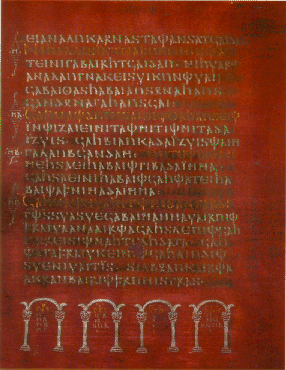 WEMSK32:Gothic
WEMSK32:Gothic
WEMSK32
WEMSK32 - Gothic
1. Surveys:
a. James W. Marchand, "Gotisch," Kurzer Grundriss der germanischen
Philologie bis 1500, ed. L. E. Schmitt, vol. 1 (Berlin: de Gruyter,
1970), 94-122. A general survey of the study of the language and
the problems this entails. If you are German-challenged, look at J.
W. Marchand, "The Gothic language," Orbis VII (1958), 492-515.
This is probably the best starting point for you, though a little
out of date.
b. Piergiuseppe Scardigli, "Gotische Literatur," Kurzer Grundriss
der germanischen Philologie bis 1500, ed. L. E. Schmitt, vol. 2
(Berlin: de Gruyter, 1971), 46-68. Survey of Gothic literature.
c. Elfriede Stutz, Gotische Literaturdenkm„ler. Realienbuecher fuer
Germanisten. Abteilung D. Literaturgeschichte (Stuttgart: Metzler,
1966). Useful survey.
2. Bibliography: Fernand Mosse, "Bibliographia gotica," Medieval
Studies 12 (1950), 237-324; "First Supplement," MS 15 (1953), 169-
183; "Second Supplement," James W. Marchand, MS 19 (1957), 174-196;
"Third Supplement," Ernst A. Ebbinghaus, MS 29 (1967), 328-343;
"Fourth Supplement," Ernst A. Ebbinghaus, MS 36 (1974), 199-214;
"Fifth Supplement," Christian T. Petersen, MS 59 (1997), 301 ff.
All of these supplements are being brought together with
corrections and additions by Christian T. Petersen, to appear soon
(Heidelberg: Winter).
3. Edition: Wilhelm Streitberg, Die gotische Bibel. I. Teil. Der
gotische Text und seine griechische Vorlage mit Einleitung,
Lesarten und Quellennachweisen sowie den kleineren Denkmaeleren als
Anhang. II. Teil. Gotisch-griechisch-deutsches Woerterbuch.
Germanische Bibliothek, II.3 (Heidelberg: Winter, 1908-1910). This
is the standard edition and has superseded all others. Its
`reconstruction' of the Greek Vorlage is seriously flawed by his
dependance on von Soden, and he is given to conjectures, but this
is the text you must use. There have been newer editions which
included, e.g. the Veronese notes. A new edition by Piergiuseppe
Scardigli, including all the recent discoveries, is to appear soon.
4. Grammars:
a. Wilhelm Braune, Gothische Grammatik mit (einigen) Lesestuecken
und Wortverzeichnis. Sammlung kurzer Grammatiken germanischer
Dialecte, I (Halle: Niemeyer, 1880). The standard grammar.
There
have been numerous editions. The latest is by Ernst A. Ebbinghaus
(Tuebingen: Niemeyer). The standard grammar. Straightforward,
sober. There is an English translation of the 4th German edition,
by Gerhard H. Balg, A Gothic Grammar, 2d ed. (Milwaukee: The
Author, 1895).
b. Joseph Wright, Grammar of the Gothic Language (Oxford: OUP,
1910); 2d ed. O. L. Sayce (Oxford: OUP, 1954). A good, sober
work;
citable.
c. Wilhelm Streitberg, Gotisches Elementarbuch. Germanische
Bibliothek I.1.2 (Heidelberg: Winter, 1897). Use the 5th and 6th
edition (1920). Streitberg followed Sievers and von Soden, so is a
little wild at times, but an excellent source for syntactical
problems, so much so that these parts have been reprinted: Hugo
Stopp, ed., Gotische Syntax (Heidelberg: Winter, 1981).
d. Hans Cronon von der Gabelentz and Julius Loebe, Ulfilas. 2 vols.
in three (Leipzig: Brockhaus, 1836; repr. 1843-46. Vol. 2.2 offers
the only relatively complete grammar of Gothic, so should be used
for any scholarly work. It is, of course, based on a Latin model
for the grammar. Also available in Migne (vol. 18.455-1560) in a
Latin translation.
e. William H. Bennett, An Introduction to the Gothic Language.
Introductions to the Older Languages of Europe 2 (NY: MLA, 1980).
Various prenatal versions exist. Not always to be trusted.
5. Dictionaries:
a. The dictionary in Streitberg's Bibel (above, Section 2) is the
standard. For a fuller dictionary, consult Ernst Schulze,
Gothisches Glossar (Magdeburg: Gebrueder Baensch, 1848).
b. If you must have one in English: G. H. Balg, A Comparative
Glossary of the Gothic Language (Mayville, WI: The Author, NY:
Westermann, London: Truebner, and Halle: Niemeyer, 1887-89).
Brian T. Regan, Dictionary of the Biblical Gothic Language
(Phoenix: Wellspring Books, 1974) takes theological concepts into
account.
6. Etymological dictionaries:
a. Sigmund Feist, Vergleichendes Woerterbuch der gotischen Sprache
mit Einschluss des Krimgotischen und sonstiger zerstreuter
Ueberreste des Gotischen. 3. neubearbeitete u. vermehrte Aufl.
(Leiden: Brill, 1939). Has been called "the best etymological
dictionary of any language."
b. Winfred P. Lehmann, A Gothic Etymological Dictionary Based on
the Third Edition of "Vergleichendes Woerterbuch der gotischen
Sprache" by Sigmund Feist (bibliography prepared under the
direction of Helen-Jo Jakusz Hewitt) (Leiden: Brill, 1986).
6. Facsimiles. There are facsimiles of almost everything; I will
just mention the larger ones:
a. Codex Argenteus Upsaliensis. Iussu senatus Universitatis
phototypice editus (Uppsala: University, 1927), 125p. 2 coloured
plates, tabulae I-X, 794p. in photogr. reproductions. folio. A
splendid work for its time, based on UV, X-ray photographs, often
two photographs of the same page. Needs badly to be redone. The
introduction, in Latin, has been brought out in a Swedish
translation: Otto von Friesen and Anders Grape, Om Codex Argenteus:
dess tid, hem och oeden. Met ett appendix av Hugo Andersson.
Skrifter utgivna av Svenska Litteratursaellskapet, 27 (Uppsala,
1928).
b. Hans Henning, Der Wulfila der Bibliotheca Augusta zu
Wolfenbuettel (Codex Carolinus), heraugegeben und eingeleitet.
(Hamburg: Erich Behrens, 1913, As Mosse pointed out, "an inferior
production." The plates are still in the library in Wolfenbuettel.
A new edition, using UV photography (done in 1958) and density
slicing, is being prepared by James W. Marchand. In it, the entire
upper script (it is a palimpsest) is removed.
c. Jan de Vries, Wulfilae Codices Ambrosiani rescripti, epistularum
evangelicarum textum goticum exhibentes, phototypice editi et
prooemio instructi. 1. Textus, 2. Cod. A et Taurinensis. 3. Cod. B
C D. (Turin: Vincenzo Bona, 1936). Unfortunately, this is almost
impossible to use, since it is based on ordinary photographs of
palimpsests treated by Angelo Mai with nut-gall.
7. There is a concordance: Magnus Snaedal, A Concordance to
Biblical Gothic, 2 vols. (Reykjavik: University of Iceland Press,
1998). It is, unfortunately, a KWIC concordance.
8. There are a number of web sites devoted to various aspects of
Gothic.